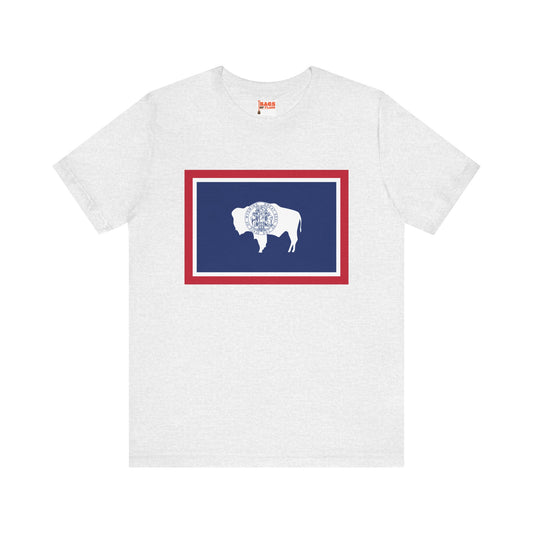-
Wyoming Pillow
Regular price $22.65 USDRegular priceUnit price / per -
Wyoming Mug
Regular price $11.65 USDRegular priceUnit price / per -
Wyoming Backpack
Regular price $59.79 USDRegular priceUnit price / per -
Wyoming Trucker Cap
Regular price $14.90 USDRegular priceUnit price / per -
Wyoming Leather Patch Hat
Regular price $18.85 USDRegular priceUnit price / per -
Wyoming Flag Sweatshirt
Regular price $34.15 USDRegular priceUnit price / per -
Wyoming Sweatshirt
Regular price $34.15 USDRegular priceUnit price / per -
Wyoming Hoodies
Regular price $34.40 USDRegular priceUnit price / per -
Wyoming T-shirts
Regular price $22.79 USDRegular priceUnit price / per -
Wyoming Flag Hoodies
Regular price $34.40 USDRegular priceUnit price / per -
Wyoming Flag T-shirts
Regular price $22.79 USDRegular priceUnit price / per -
Wyoming State Flag – USA States Flags
Regular price From $40.26 USDRegular priceUnit price / per
Collection: US State: Wyoming WY flag
The Wyoming flag is a symbol of pride and heritage for the state. With its unique design and colors, it stands out among the many state flags of the United States. We will explore the flag's history, symbolism, relevance, and interesting facts.

Overview of the Wyoming Flag
The Wyoming flag showcases a central emblem featuring a bison, which stands as a nod to the state’s rich fauna and its historical significance as the "Buffalo State." This emblem is set against a deep blue field, bordered on two sides by bands of white and red. The blue embodies the vast, open skies and distant mountains characteristic of Wyoming's landscape, while the white symbolizes purity and uprightness.
Red, encircling the white, represents the Native Americans and the blood of pioneers who laid down their lives to reclaim the soil. This carefully chosen palette depicts the natural beauty and spirit of Wyoming and pays homage to its history and the diverse cultures that have shaped it. The flag’s design is simplistic yet profound, encapsulating the essence of Wyoming through color and symbolism.
Historical Context
The journey of the Wyoming flag to its current status began in the early 20th century, specifically in 1917 when the state sought to adopt a unique banner that would embody its values and identity. This period was marked by a growing sense of statehood and the desire among states to have symbols representing their distinct characteristics. Against this backdrop, the Daughters of the American Revolution in Wyoming launched a competition to design the state flag, a contest that attracted numerous entries from across the state.
The winning design came from Verna Keays, a young artist from Buffalo, Wyoming, whose vision for the flag resonated with the selection committee. Her design skillfully incorporated elements that captured the spirit and essence of Wyoming, leading to the flag's official adoption by the state legislature in 1917. Since its inception, the flag has remained largely unchanged, a testament to the enduring nature of its design and the universal appeal of its symbolism.
Keays' victory in the flag design competition not only marked a significant milestone in the history of the Wyoming flag but also underscored the importance of local culture and heritage in creating state symbols. The adoption of the flag was a historic event for Wyoming, reflecting the state's pride and identity at a time when the United States was experiencing significant social and political change.
Symbolism Behind the Flag
At the heart of the Wyoming flag's symbolism is the bison, an iconic representation of the state's abundant wildlife, its history of the Western frontier, and a nod to its nickname, the "Buffalo State." The bison embodies strength, resilience, and the spirit of independence, qualities deeply ingrained in the state's identity. The emblematic beast is shown with the state seal branded on its flank, linking the flag to Wyoming's governmental and historical roots.
Surrounding the central figure, the blue field captures the essence of Wyoming's expansive skies and rugged mountains. At the same time, the white border symbolizes purity and the high moral values held by its people. The red outer border acknowledges the sacrifices of both the Native Americans and pioneers, adding a layer of respect and remembrance to the flag's narrative. This combination of elements and colors on the Wyoming flag weaves a story of natural beauty, enduring strength, and a commitment to principles of freedom and courage, reflecting the core values and spirit of Wyoming and its residents.
Current Relevance
Today, the Wyoming flag continues to play a significant role in the state's cultural and political landscape. It is prominently displayed at state government buildings, where it represents the state's authority and sovereignty. During military ceremonies, the flag is honored alongside the national colors, symbolizing the state's respect and support for its service members and veterans. At national events, the presence of the Wyoming flag underscores the state's unity and participation in the broader American community.
In educational settings, the flag serves as a tool for teaching students about Wyoming's rich history, diverse cultures, and the state's values. Discussions around the flag often lead to deeper conversations about patriotism, state identity, and the significance of symbols in representing communal ideals.
Although the Wyoming flag is cherished by many, it has not been immune to controversies. Debates have arisen over its design elements and what they represent in the modern context. These discussions are valuable as they encourage reexamining historical symbols and their relevance in today's society. Such dialogues underscore the dynamic relationship between a state and its symbols, highlighting how they can evolve or be reinterpreted over time. The Wyoming flag remains a living emblem through these conversations, continuously engaging the people it represents.
Additional Facts
When displaying the Wyoming flag alongside the national flag, it must be accorded equal prominence and respect, reflecting the state's status within the Union. Protocols dictate that the flag should be treated with the utmost care, ensuring it is never allowed to touch the ground as a sign of respect and dignity. During mourning or significant loss, the Wyoming flag is lowered to half-mast, a poignant tribute to individuals who have substantially contributed to the state or its people.
A lesser-known fact about the flag is the affectionate nickname given to the bison depicted on it, "Old Bill," which has endeared itself to the residents of Wyoming, further cementing the flag's role in the state's cultural identity. Additionally, the inclusion of an animal, particularly the bison, as the central figure makes the Wyoming flag distinct among state flags, highlighting its unique connection to the state's natural heritage and history. These facets contribute to the flag's significance and the protocols surrounding its display and handling, reflecting Wyomingites' pride and respect for their state symbol.
























